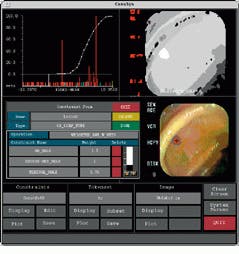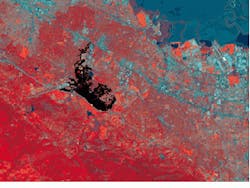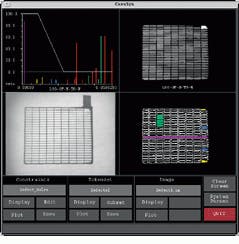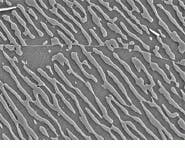PATTERN-RECOGNITION SYSTEMS USE TO ADD INTELLIGENCE
PATTERN-RECOGNITION SYSTEMS USE TO ADD INTELLIGENCE
By Barry Phillips, Contributing Editor
After years of incubation, fuzzy set technology has emerged from the laboratory and is now making major contributions to complex image-processing systems. Fuzzy logic rules and relaxation capabilities are being embedded in commercial pattern-recognition software, improving the effectiveness of color template matching and feature analysis.
Once an image is captured, finding areas of interest can be accomplished in many ways. Traditionally, this involved searching using thresholds and discreet templates. But by using fuzzy logic, patterns that cannot be detected using IF-THEN logic can be found.
"Multiple units of knowledge, represented by fuzzy logic functions, can be combined together to make classification decisions, closely mimicking the human decision-making process," says Peter Eggleston, director of marketing at Amerinex Applied Imaging (AAI; Amherst, MA).
Amerinex uses fuzzy logic to aid image interpretation and classification in the constraint system module of its KBVision image-processing toolkit. With the toolkit, a series of feature comparisons can be defined. Because features from a single data source might not uniquely classify an object, the fuzzy logic rules can define a series of analytical steps derived from a variety of data sets and sources.
Fuzzy analysis
Fuzzy analysis can combine multiple geometric, spatial, and color attributes, and multispectral image information. Fuzzy logic rules can represent the fusion of data from computed tomography (CT), magnetic-resonance-imaging (MRI) scanners, and visible and infrared (IR) sensors. Rules can combine the analysis of several types of data, such as temperature data derived from IR sensors, color and texture information derived from visible sensors, and tissue-density data computed by CT systems.
AAI`s fuzzy-based constraint system is being used in endoscopic screening to locate and quantify abnormalities such as tumors and lesions in the esophagus (see Fig. 1). Analysis consists of a set of fuzzy logic rules that follow the process humans use to detect and measure lesions. Operators examining medical images for lesions look for areas that are redder than the surrounding tissue, tend to have irregular shapes, and are denser than normal tissue.
Fuzzy logic approaches allow these nonunique features to be combined to create classification schemes that can be understood by the inexperienced user. But the algorithm captures the knowledge an expert would use to approach the pattern-recognition problem.
High-level structures
Fuzzy-rule bases consist of high-level data structures that find regions or patterns within images. Because the rules and filtering methods are not embedded in the image-processing application program, the fuzzy-rule base can be revised at any time. This makes fuzzy methods portable between different data sets. Similar images with different base lighting and different color table characteristics can be searched using the same basic fuzzy rules with minor modifications.
Fuzzy constraint systems can be used to construct modular and reusable imaging code. Adaptable knowledge-based applications can compensate for erroneous knowledge, dynamically changing data and noise. To compensate for the infinite amounts of variation, fuzzy logic constraints mimic the subjective reasoning of human experts.
Classification schemes can be created based on small training sets, as statistics are not involved, according to Eggleston. "With fuzzy constraints, data interpretation is based on plausibility, not probability. Classification is based on supporting information present in the data and is not dependent on the frequency of occurrence," he said.
Conversely, statistical and neural-network-based approaches need a hundred or more training samples at a minimum. Often, such systems are sensitive to the order and frequency of occurrence of the classes being represented in the training data, a problem that does not affect fuzzy-logic-based systems.
Fuzzy color
Fuzzy technology is proving beneficial in low-level color pixel-matching applications. Avian Systems (Tenafly, NJ) has developed a core imaging technology called FullPixelSearch that combines fuzzy color template matching and fuzzy region growing capabilities to find patterns that cannot be explicitly defined.
According to Richard Podolsky, a principal at Avian Systems, by relaxing the degree of fuzziness in a color template search, many more possible regions can be identified in an image than by explicitly defining the pixel patterns and color table being compared.
Straight histograms can yield false positive pixels and regions because the color values in the regions being looked at often appear elsewhere in the image. With FullPixelSearch, a color template made up of an arbitrary set of connected pixels is used as a "seed" template. Then fuzzy constraints on the color values required to produce a match can be relaxed. According to Podolsky, the knowledge gained from analyzing the patterns found in one scanning-electron-microscope slide of an image, such as a cross section of a piece of metal, can be applied to different alloys with different color properties.
Fuzzy match and grow features of FullPixelSearch can simulate the spread of wildfire (see Fig. 2 on p. 41). The black region shows the final polygon of a wildfire that starts in the grasslands just to the east of Stanford University`s linear accelerator. To generate this result, FullPixelSearch searches the image to match a pixel-based template that has been loaded with pixel values known to be flammable. This stage of the analysis in essence "sets" the fire and generates an active perimeter for further growth.
Next, the fuzzy grow feature is used to "grow" this core area, and here the fuzzy rule tells the system to consume pixels known to correlate with flammability as they are encountered along the active edge of the fire and to add them to the polygon until no more flammable vegitation is encountered. It is also possible to alter vegetation parameters and model cases where fires jump to new areas of the landscape.
By incorporating human-like knowledge in the algorithms used for image analysis, fuzzy searching can help automate repetitive manual image-characterization tasks. Once fuzzy constraints have been proven for a given image application, this knowledge can be maintained and transferred to related problems to overcome noise, environmental factors, changes in color tables, or lighting.
FIGURE 1. To compensate for infinite amounts of variation, fuzzy logic constraints mimic the subjective reasoning of human experts. In this application, rules are developed and applied to endoscopic images to detect and measure lesions in the esophagus.
FIGURE 2. A commercial SPOT/image satellite photo of the terrain surrounding the Stanford University Linear Accelerator (SLAC) in Palo Alto, CA, was generated using Avian System`s FireTower program, which locates flammable vegetation and simulates fire patterns based on fuzzy analysis of patterns and color tables. Running this simulation allows disaster managers to decide where to invest in fire breaks to maximize the amount of land saved.
Using fuzzy logic to create pattern-recognition systems
In the past, traditional pattern-recognition systems have been hand-coded custom designs. From a reverse-engineering viewpoint, it may be difficult to understand how such systems operate.
A more intuitive approach uses fuzzy logic to filter and interpret information from images. To construct such recognition systems, fuzzy-logic systems incorporate `rules` about how information in images should be interpreted and classified. Multiple units of knowledge, represented as fuzzy-logic functions, can be combined to make classification decisions that closely mimic the human decision process. Because these functions are not binary, they are flexible and forgiving in the presence of noise, data ambiguity, and training inaccuracies. Such systems allow the developer to examine different methods to discover which features identify abnormalities.
In a manufactured component of a lead-acid battery, size invariant features such as log-of-height-to-width can identify a missing stitch (see figure). Here, the information about the decision is not embedded in any code. Rather, the information is a graph showing the relationship between the features being used in the classification process, and the classification decision.
Red spikes comprise a histogram showing the distribution of all objects in the image, given some feature such as log of height to width. Features such as shape, texture, and spatial and relationships to other objects in the image can be used.
White lines show the class mapping along the feature space. In this example, classes are defect and nondefect. Because the mapping uses values between zero and 100 to represent class membership, the resulting mapping function is `fuzzy.` That is, objects that map to values other than zero or 100 only have partial membership to a class. Multiple fuzzy mappings can be ganged as a larger function so that many features can be used in the classification process. This is similar to the process of stacking audio filters such as low pass, bandpass, and high pass, in that filters are selected so that only the frequencies of interest are amplified.
In imaging, these filters can be combined so that only objects of interest are assigned to their respective classes and thereby `recognized` or `interpreted.` When used with segmentation and feature-extraction capabilities, application developers can create knowledge-based applications that mimic domain experts. In the case of a medical diagnosis system, a physician could quickly enter `knowledge` about how he/she interprets data by creating a set of fuzzy-logic rules. The resulting application could then use these rules to duplicate the physician`s often ad hoc decision-making process.
Peter Eggleston
Amerinex Applied Imaging
Amherst, MA 01002
http://www.aai.com
Fuzzy logic locates a mold defect in a lead-acid battery grill. Here, shape is used as a discriminator, but other attributes of the data such as color, texture, and adjacency to other potential defects could be used.
Fuzzy software performs stress analysis fast
When performing analysis on images from electron microscopes, it is often necessary to quantify different areas within images. In metallurgy, for example, lightweight alloys may generate images with light and dark phases. By calculating the ratio of light to dark regions, the amount of stress in the alloy can be determined. But because the two phases are often not discrete, simply counting pixels in such images does not provide an accurate way of determining stress.
Using fuzzy-logic-based searching and growing techniques, however, speeds the process and allows an accurate determination to be made. In such methods, image templates must first be developed with fuzzy boundaries. Then, by applying a fuzzy growing routine to the template, the pattern search can find hidden patterns that would otherwise go undetected (see figure).
First, a template with appropriate fuzzy bounds is constructed and used to "seed" the dark phase of the original image (top) producing an intermediate image (middle). Then, a fuzzy-unbounded-grow operation is applied at the perimeter of each seed template to grow them until they saturate the dark phase. The resulting image (bottom) is then used to calculate a 62% stress area. This method of fuzzy searching and growing is faster than traditional methods. The result was generated in less than 10 seconds per image on a Power Mac 8500/180.
Once a strain template is constructed for a particular color table, it can be applied to an image with a different color table by expanding the search using the fuzzy growing routines. A batch-mode interface is under development to automate these processes.
Richard Podolsky
Avian Systems
Tenafly, NJ 07670
E-mail: [email protected]





